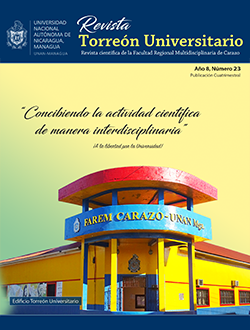Operation of working memory in users of senior centers
DOI:
https://doi.org/10.5377/torreon.v8i23.9525Keywords:
working memory, seniorsAbstract
The study aims to assess the level of working memory function in a group of senior centers users from Carazo department during the second half of 2019. Method: The study used a quantitative approach, which allowed the description and establishment of the relationship of the variables under study; a non-experimental, cross-sectional design was used, with a descriptive-correlational scope. The sample consists of 32 adults over the age of 60, both sexes and users of Asylum Agustín Sánchez and La Purísima senior social canteen. The Working Memory Index from the Weschsler Adult Intelligence Scale (WAIS III) was applied, composed by the subtests Arithmetic, Digit retention and Letters and numbers sorting. Descriptive and inferential statistics were used, which allowed the hypothesis contrast to be realized. Results: Results indicate that there are working memory difficulties in participants and presents problems in the ability to manipulate information, have attentional control, planning capacity, organization and temporary and active storage of verbal, visual and spatial information.
Downloads
828
PDF 193
HTML (Español (España)) 478
HTML 152
References
Ardila, A., y Rosselli, M. (2007). Neuropsicología Clínica. México: Editorial El Manual Moderno.
González, B., y Muñoz, E. (2008). Estimulación de la memoria en personas mayores. Madrid: Editorial Síntesis, S.A.
Hasher, L., Zacks, R., y Rahhal, T. (1999). Timing instructions, and inhibitory control: some missing factors in the age and memory debate. Gerontology, 45. 355-357.
Herreras, E. (2007). Función ejecutiva: evaluación y rehebilitación neurológica. Revista de Educación, 21 (9), 291-300.
Nastayashchada, E., y López, L. (2015). Diferencia entre hombres y mujeres en memoria de trabajo. Revista Neuropsicología, Neuropsiquiatría y Neurociencias, 15 (2), 35-51.
Ostrosky, F., y Lozano, A. (2011). Desarrollo de las funciones ejecutivas y la corteza prefrontal. Revista Neuropsicología, Neuropsiquiatría y Neurociencias, 11 (1), 159-172.
Portellano, J. (2005). Introducción a la Neuropsicología. Madrid: Editorial McGraw-Hill.
Portellano, J., y García, J. (2015). Neuropsicología de la atención, las funciones ejecutivas y la memoria. Madrid: Editorial Síntesis, S.A.
Ramos, P., Sopena, J., y Gilboy, E. (2007). Memoria de trabajo, atención y composicionalidad. Anuario de Psicología, 38 (1), 93-116.
Tirapu, J., Muñoz, J., & Pelegrín, C. (2002). Funciones ejecutivas: necesidad de una integración conceptual. Revista de Neurología, 34 (7), 673-685.
Downloads
Published
How to Cite
Issue
Section
License
Los autores que publican en esta revista están de acuerdo con los siguientes términos.
- El autor o los autores de los artículos, ensayos o investigaciones conceden a la Universidad Nacional Autónoma de Nicaragua, Managua (UNAN-Managua) los derechos de edición (copyright) del trabajo enviado, por consiguiente la Universidad cuenta con el derecho exclusivo para publicar el artículo durante el periodo completo de los derechos de autor.
- Estos derechos de autor/ autores autorizan a la Revista Torreón Universitario y a la Universidad editar y divulgar/publicar el artículo en dicha Revista, incluyendo reproducción impresa y electrónica, el almacenamiento, recuperación y cualquier otro tipo de publicación, y fuentes de información secundaria como servicios de resúmenes y bases de datos, así mismo la facultan a proteger el artículo contra el uso no autorizado para su difusión por medios impresos o electrónicos (PDF, HTML, EPUB, XML u otros).
Licencia para el uso del contenido
La revista hace uso de la Licencia Creative Commons Atribución-NoComercial-SinDerivar 4.0 Internacional.
Bajo esta declaración:

Este revista está sujeta a una licencia de Creative Commons Reconocimiento-NoComercial-SinObraDerivada 4.0 Internacional. Puede ser copiada, distribuida y transmitida públicamente siempre y cuando se cite al autor y la fuente (Revista Torreón Universitario), no debe modificarse ni utilizarse con ningún fin comercial. La licencia completa se puede consultar en http://creativecommons.org/licenses/by-nc-nd/4.0/.



